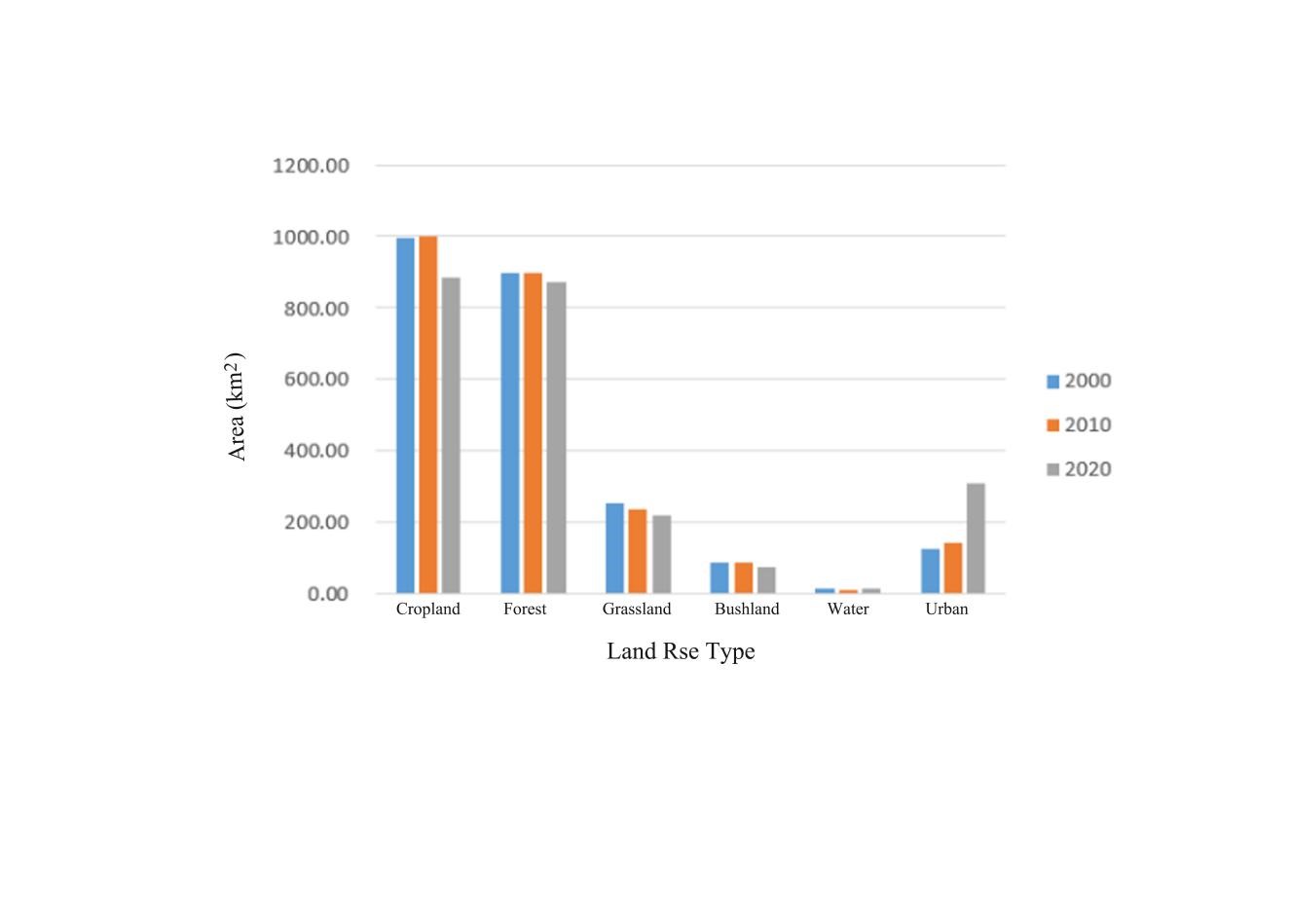Study on Land Use Change and Its Impacts in the Nanming River Basin
Abstract
Land use significantly affects river basin water quality directly and indirectly through landscape pattern changes. This study analyzed land use changes in the Nanming River Basin in 2000, 2010, and 2020, calculating landscape pattern indices for different buffer zones in 2010 and correlating them with water quality data. Key findings: From 2000 to 2020, grassland area decreased while artificial surfaces expanded, with landscape fragmentation declining as buffer scales increased. Upper reaches had better water quality than lower reaches, though both sections showed significant nitrogen pollution. Higher proportions of cropland and artificial surfaces correlated with worse pollution, while grassland and forest land strongly inhibited pollutants. Reduced landscape fragmentation benefited water quality, and more standardized artificial surface shapes had stronger positive effects.
References
[2] Deng, Y. (2020). Research on the technology and application of land use dynamic monitoring based on 3S. Value Engineering, 39(20), 203–204.
[3] Hu, H. (2013). Study on watershed land use change and its impact on river water quality under the background of urbanization [Doctoral dissertation, Nanjing Normal University].
[4] Allan, J. D. (2004). Landscapes and riverscapes: The influence of land use on stream ecosystems. Annual Review of Ecology, Evolution, and Systematics, 35, 257–284. https://doi.org/10.1146/annurev.ecolsys.35.120202.110122
[5] Cole, L. J., Stockan, J., & Helliwell, R. (2020). Managing riparian buffer strips to optimise ecosystem services: A review. Agriculture, Ecosystems & Environment, 296, 106891. https://doi.org/10.1016/j.agee.2020.106891
[6] Ding, J., Jiang, Y., Liu, Q., Hou, Z., Liao, J., Fu, L., & Peng, Q. (2016). Influences of the land use pattern on water quality in low-order streams of the Dongjiang River basin, China: A multi-scale analysis. Science of the Total Environment, 551–552, 205–216. https://doi.org/10.1016/j.scitotenv.2016.01.162
[7] Xu, S., Li, S., Zhong, J., & Li, C. (2020). Spatial scale effects of the variable relationships between landscape pattern and water quality: Example from an agricultural karst river basin, Southwestern China. Agriculture, Ecosystems & Environment, 300, 106999. https://doi.org/10.1016/j.agee.2020.106999
[8] Gong, P., Liu, H., Zhang, M., Li, C., Wang, J., Huang, H., Clinton, N., Ji, L., Li, W., Bai, Y., Chen, B., Xu, B., Zhu, Z., Yuan, C., Suen, H. P., Guo, J., Xu, N., Li, W., Yao, Y., . . . Yu, C. (2019). Stable classification with limited sample: Transferring a 30-m resolution sample set collected in 2015 to mapping 10-m resolution global land cover in 2017. Science Bulletin, 64(6), 370–373. https://doi.org/10.1016/j.scib.2019.03.002
[9] Shi, P., Zhang, Y., Li, Z., Li, P., & Xu, G. (2017). Influence of land use and land cover patterns on seasonal water quality at multi-spatial scales. Catena, 151, 182–190. https://doi.org/10.1016/j.catena.2017.01.017
[10] Liu, Y. (2018). Analysis of the influence of landscape pattern indices on water quality in the Hun River Basin. Ground Water, 40(2), 55–57.
[11] Fang, Y., Li, Z., Zeng, G., et al. (2007). Study on characteristics of surface water environment in typical watershed of red soil hilly region—Taking Liuyang River Basin as an example. Environmental Monitoring in China, 23(4), 85–89.
[12] Feng, Y., Yang, Q., & Qiu, C. (2015). Response of water quality to landscape pattern evolution in the Nanming River Basin. Research of Environmental Sciences, 28(12), 1852–1861.
[13] Yang, Y., Wang, J., Chen, G., et al. (2016). Relationship between land use pattern and water quality change in Fuxian Lake Basin. Remote Sensing for Land & Resources, 28(1), 159–165.
[14] Xing, K., Guo, H., Sun, Y., et al. (2005). Simulation study of non-point source pollution in watershed—A case study of Dianchi Lake Basin. Geographical Research, 24(4), 549–558.
[15] Yu, X., & Yang, G. (2003). Typical watershed land use/cover change and its impact on water quality—Taking Xitiaoxi River Basin in Zhejiang Province upstream of Taihu Lake as an example. Resources and Environment in the Yangtze Basin, 12(3), 211–217.
[16] Su, Z. (2021). Study on the response relationship between land use and river water quality in the Ba River Basin [Doctoral dissertation, Chang’an University].
[17] Jiao, S., Yang, N., Peng, K., et al. (2014). Impact of land landscape pattern on river water quality in the Wei River Basin. Geographical Research, 33(12), 2263–2274.
[18] Zhang, Y. (2020). Study on the impact of landscape pattern changes at different scales on water, sediment, and water quality in the Danjiang River Basin [Doctoral dissertation, Xi’an University of Technology].
[19] Pu, J., Zhao, X., Gu, Z., et al. (2018). Landscape pattern and water quality change in the Qilu Lake Basin, Yunnan Plateau. Journal of Hydroecology, 39(5), 13–21.
[20] Qi, J., & Zhou, C. (2017). Correlation analysis between land use pattern and water quality in the Hanfeng Lake Basin, Kaizhou. Sichuan Environment, 36(1), 58–63.


This work is licensed under a Creative Commons Attribution 4.0 International License.
Copyright for this article is retained by the author(s), with first publication rights granted to the journal.
This is an open-access article distributed under the terms and conditions of the Creative Commons Attribution license (http://creativecommons.org/licenses/by/4.0/).
























